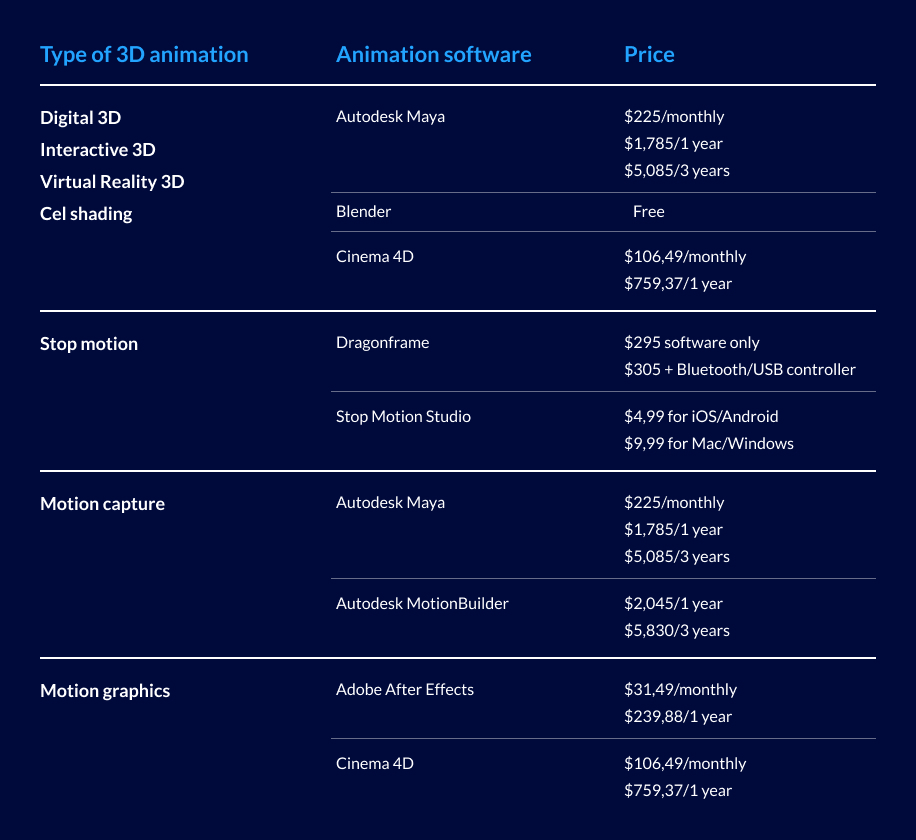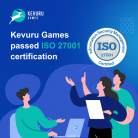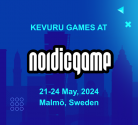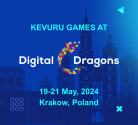3D animation is becoming more and more common. It takes us by surprise in yet another movie scene that is impossible in real life, excites the imagination with the richness of forms and colors in advertising, immerses us in completely different worlds in computer games. Its amazing ability to break down the boundaries between the real and the imaginary sometimes makes it impossible to determine what is in front of us – a natural shooting or a carefully designed and implemented computer simulation.
Animation offers a medium of storytelling and visual entertainment which can bring pleasure and information to people of all ages everywhere in the world.
Walt Disney, animator, writer, voice actor, and film producer
Unlike 2D animation, 3D animation invites the viewer into a space of height, width, and depth, providing maximum realism and stunning detail. But 3D animation is just a general name for the 3D realm, which includes a wide variety of animation types. Let’s try to understand their direct classification series and understand what they are and where they are used.
The Unbearable Variety of 3D Animation Art Styles
The very name of 3D animation implies that here we are talking about giving movement to a certain three-dimensional object.
If a 2D drawing cannot be viewed from all sides, and the animator needs to create a separate angle for each of them, then the 3D figure perfectly rotates 360 degrees, approaches, and moves away at the discretion of the animator. Thus, a frame-by-frame cycle with strict compositional rules of 2D animation turns into complete freedom of angles in the case of 3D.
This is the main thing we need to know about the differences between 2D and 3D animation in the first place. Now let’s go directly to the types of 3D animation.
Dive Deeper:
✔ 2D Animation vs 3D Animation: The Battle of Dimensions
Digital 3D
Also known as computer-generated imagery, digital 3D animation is the creation of animation and special effects using computer software such as Maya, Cinema 4D, and SketchUp.
A feature of this type of animation is the scope of its application. This is mainly cinematography – creating visual effects and scenery that cannot be achieved or obtained by traditional methods, or replacing the work of stuntmen with especially dangerous stunts. It is also used to create digital characters for live-action films and video game action videos (Stormdivers by Housemarque with character animation by Kevuru Games).
This type of 3D animation is purely for visual perception – viewers do not interact with objects in the digital environment.
The essence of animation is to create a 3D model of a character, set certain positions, known as keyframes, and use the spline system to determine the movement of the character in these positions. The program interpolates the necessary frames by connecting the key ones, after which the animator refines the details.
Thus, 3D animation is a complex and time-consuming process that requires the involvement of several specialists at once:
- Сoncept artist
Visualizes the main idea and makes detailed sketches of a character or object with all possible nuances. - 3D modeler
Takes the baton and creates a 3D model based on concept art. - 3D animator
Creates a skeleton for the 3D model, rigs it with bones and controls, and sets its movement.
It is important to understand that the animator has a huge amount of work. Unlike the hand-drawn frames of a 2D animation, every part of a 3D character or object in a 3D animation is always in view and needs to be worked on whether it transitions into the next second or not.
When rendering, each frame is processed by the computer separately, so the process takes a long time. It depends on the length of the animation and the quality of the image.
Interactive 3D
Interactive 3D animation is created exclusively digitally using special software; it enables interaction between the viewer and objects in the digital environment.
This is a classic version of the creation of computer video games. The player has the ability to navigate the 3D environment using the mouse, keyboard, or joystick.
The possibilities for implementing this kind of animation are great and are only limited by the game engine. But Kevuru Games knows how to skillfully weave any ideas of 3D animation and the limitations of game engines into a single organic canvas. This is quite possible if there is experience, skills, and creative vision on board.
Due to the possibility of interaction, animation has special requirements. It should be highly customizable as the player can approach an object from different angles and under different conditions. Animators need to carefully work out the dynamics of the animated 3D background and ensure smooth transitions of shapes at the right time. The same goes for character animation. The main character must clearly fulfill all control requests from the player.
Virtual Reality 3D
3D virtual reality is a simulated experience that uses posture tracking and 3D displays near the eyes to give the user the feeling of being immersed in a virtual world.
Partially similar to interactive animation, this type takes a step further towards total immersion. The exploration of the three-dimensional world is carried out using special VR headsets such as Google Glass or Oculus. For example, Boneworks by Stress Level Zero is a virtual reality game that uses the Unity engine, which supports all PC-compatible VR headsets.
Producing animation for VR games is extremely difficult. Since the player is literally immersed in them completely, all the environments and elements must be perfectly designed and look like real ones.
Augmented reality animation is also common in the gaming world. Games with it do not require special headsets and are often released for Android and iOS. All you need is an AR-enabled smartphone. A legendary example is Pokémon GO, which brought augmented reality games to millions of players. The combination of impact on nostalgic feelings and the use of modern technology, previously known only to a small circle of people, has brought the game several Guinness records and staggering profits.
Stop Motion
Stop motion is a frame-by-frame technique in which objects are physically manipulated in small steps between individual photographed frames to depict independent movement as a series of frames plays in quick succession.
This is a kind of homage to 2D animation. Simply put, animation is created by shooting elements frame-by-frame. The scope for creativity here is unlimited. You can use objects, toys, products, dolls, and so on. Most often, this type of animation is used for commercials, presentations, and music videos.
Stop motion animation is divided into different subspecies depending on the objects used:
- Claymation – clay or platinum objects.
- Cutout – characters, objects, and backgrounds are cut out of flat material: paper, cardboard, or fabric.
- Silhouette – flat characters, objects, and backgrounds depicted in the form of black silhouettes.
- Action figures/Lego – Lego characters or action figures.
- Puppet – dolls and puppets.
- Pixilation – live people and existing environments.
Regardless of the chosen object, stop motion animation animation requires you to follow the main rule – only photograph directly from the same angle. Correcting an incorrectly shot frame is very difficult, because for this, you need to recreate the entire composition at a particular moment. Therefore, this type of animation requires special attention and patience.
Cel Shading
Also known as toon shading, cel-shaded animation is a 3D stylization to make it look like hand-drawn flat art.
Therefore, if you come across the question of how to make a 3D animation look like 2D, feel free to answer that this can be done using cel shading. This effect is achieved by special rendering settings. Cel shading is very commonly used in video games (Afro Samurai by Bandai Namco or Astral Chain by PlatinumGames), cartoons, and commercial videos.
The main features of this technology are:
- Non-photorealistic textures in a soft color palette.
- Hard shadow boundaries.
- Ink contour effect in the best traditions of the hand-drawn style.
The point is to make the volume look flat in real time. Shadows should be smooth and uniform. These rules are more difficult to implement in practice than when creating realistic objects, and often they only apply to stationary or non-animated bodies. For example, this is implemented in many 2D animated series such as The Simpsons or Futurama.
Motion Capture
A must-have for developers of films, AAA titles, and mobile projects, motion capture technology allows for truly realistic character movement and virtually any scene by capturing the movement of people and objects with special sensors.
The main use of mocap is to record the movement of an actor to animate characters. Animals such as horses and dogs are often recorded. Sometimes mockup data is used as a reference for further manual character animation. The main advantage of a mocap is that the animator immediately gets the correct weight and timing of the character. Realistic movements are often not as smooth and accurate as in the cartoon, and it’s just that this liveliness is quite difficult to revive with just your hands.
The first to make all game animation entirely motion capture was Quantic Dream, which released Fahrenheit in 2005. Along with this, a whole series of cinematic games was born, culminating in Death Stranding.
Modern engines like Unreal Engine 5 make it easier and faster to work on a mockup because it helps with pre-rendering and allows you to see the entire scene at a glance. Mocking is much easier today than ten years ago. Actors can see their 3D avatars and surroundings right on set.
With the development of technology and graphics in games and films, a combination of Performance Capture is increasingly used instead of Motion Capture. Thus, the merits of the actors are emphasized, both those who are responsible for the movements of the characters, and celebrities who give faces and voices to computer models.
Collaboration with dozens, if not hundreds of actors has long been an integral part of production, and being involved in the development of a game for Keanu Reeves, Mads Mikkelsen, or Norman Reedus today is as exciting as filming a blockbuster.
Motion Graphics
Motion design is the process of creating animated graphics based on the principles of graphic design.
This is a large section that includes both 2D and 3D directions and has a huge scope: commercials, television programs, product and explanatory videos, presentations, sports events, live broadcasts and much more, where the dynamic movement of text, logos, and other images may be helpful.
As a rule, characters are not involved here due to the difficulty of implementing their movement when you need to create fast and high-quality motion graphics. But the number of logo animation options, visual effects, and the ability to add 3D animation allow creating a huge variety of high-quality corporate videos, animated videos for product presentations, creative resumes, and much more.
Motion graphics design technology is the use of keyframes and motion animation to provide smooth transitions. Modern technology allows anyone to quickly create motion graphics, even for online videos and streams.
Motion Wizard Toolkit, or Simply 3D Animation Software
Let’s take a short break before the last push and cast a glance at the main animation tools that allow you to create nothing less than miracles.

3D Animation Techniques Worth Paying Attention To
If we are already so well-versed in the varieties of 3D animation, then why not extend the result and add to our knowledge the top 3 animation techniques used by animators around the world.
Skeletal Animation
Also referred to as rigging, skeletal animation is a technique that involves animating a 3D figure with relatively few controls that resemble the skeleton or structure of a puppet in appearance and action.
Each bone is attached to the previous one, taking into account the anatomical rules, so that when a single bone moves, all the vertices attached to it also move. This greatly simplifies the work of the animator, since you need to set the position and rotation of the bones, and not all the existing vertices of the model. The vertex movements are ultimately calculated based on the movement of the bones. The skeleton itself is called a rig, and the surface representation of the model is called a mesh or skin.
Inverse Kinematics
Inverse kinematics is an animation method, the essence of which is to find a set of joint configurations that would provide the smoothest, fastest, and most accurate movement to given points.
It is most often used to work out the movements of the arms and legs of characters and is applied to the models of any characters or objects created using skeletal animation. Movement is achieved by setting the position of the last bone in the chain of bones, and the rest of the bones are automatically positioned in the right place. For example, if you animate the grip of an object with your fingers, then the wrist will naturally move in the right direction.
This is its difference from forward kinematics – then, in order to bring the character’s hand to the object and take it, you must first give it a general position by moving the shoulder, then set the position for the forearm and, last of all, turn the hand in the right direction and make sure that the object captured by fingers.
Fluid Simulation
The name defines the purpose of this technique – fluid simulation is animating fluids such as water, lava, or smoke.
The bottom line is to simulate the movement of liquids as close to reality as possible. Due to this, you can create impressive pictures of thunderstorms and storms. The same technique is used if it is necessary to illustrate the behavior of fire or large-scale atmospheric phenomena. Therefore, it is popular not only for games, but also for movies and even commercials.
The Bottom Line
Well, that’s all, now you know about the most famous types of 3D animation and their use cases. 3D animation continues to penetrate the most diverse areas of our life and expand the boundaries of reality. If you’re considering creating your own animation, you can try your hand at the programs we’ve listed, or … Or just drop us a few words about your wishes – we’re extremely passionate about animation and will be happy to help you.










